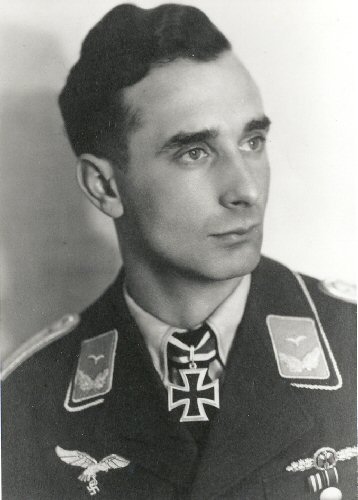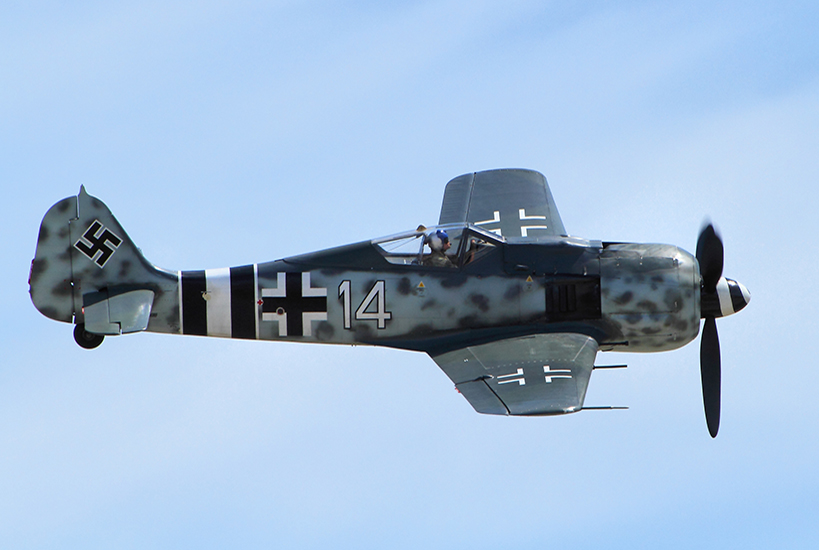Seeger, Günther "Hupatz" (JG 53)
- Date of birth:
- November 9th, 1918 (Offenbach am Main/Hesse, Germany)
- Date of death:
- September 6th, 2013
- Nationality:
- German
Biography
Günther "Hupatz" Seeger was born in Offenbach near Frankfurt am Main, September 9th, 1918, and was one of three brothers who survived the war. In 1937, he was drafted into the RAD, Reichs Arbeits Dienst (State Workers Unit) but was chosen for training as a fighterpilot for which he was transferred to Weineuchen. War broke out when he was completing his training. He was ultimately posted to 3 /JG2 Jagd Geschwader (Fighter Squadron), commanded by Staffelkapitän (Squadron Leader) Henning-Strumpell at Frankfurt-Rebstock Air Base. During the French campaign, he flew as NCO (non-commissioned officer) and on May 20th, 1940, saw action for the first time over the Cambrai-St. Quentin area where 3/JG2 claimed to have shot down no less than eight Lioré et Olivier LéO 451s, a French medium range bomber. June 8th, 1940, he scored his first victory by shooting down a French Morane-Saulnier MS 406 fighter over Soissons.
During the Battle of Britain, 3/JG2 was based at Beaumont-le Roger. Seeger claimed three victories again, including two RAF Spitfire fighters on September 7th, 1940, bringing his number of kills to four. He was active on the front over the Channell up to December 1942 and flew in the Geschwaderstab (Staff Squadron) as Rottenflieger (wingman) alongside better known aces such as Wilhelm Balthasar, Erich Leie, Rudi Pflanz and Major Walter Oesau for many months. During the Allied landings at Dieppe, August 19th, 1942, Oberfeldwebel Seeger shot down three Spitfires, raising his number of kills to 22. During this engagement however, he was shot down himself and was forced to bail out of his Focke-Wulf Fw 190-A3, slightly injured. In November, Seeger was transferred to 11/JG2, equiped with Messerschmidt Bf 109G fighters and the unit was relocated to the Mediterranean.
11/JG2, commanded by Oberleutnant Julius Meimberg was stationed in central Tunisia where it was subordinate to 11/JG 53. Seeger was promoted to Leutnant after having scored his 24th victory. During his stay in North-Africa, Seeger scored nine kills before the unit was withdrawn to Sicily.
February 1943, 11/JG 2 was disbanded and incorporated into 11/JG 53 and Seeger was posted to 7/JG 53. He scored 15 victories over Sicily and southern Italy, including his first four-engined bomber on March 22nd, 1943. February 1944, after the fall of Italy and a period of recuperation from malaria, Seeger was transferred to 4/JG 53, operating in Germany and tasked with defending the German Fatherland. In the skies over his homeland, he fought with great tenacity, partly out of personal grief, since in October 1943, during an Allied air raid over Offenbach, his parental home had been destroyed. His mother had been killed and his father had barely escaped with his life but spent many months in hospital. March 26th, 1944, he was awarded the Ritterkreuz (Knight's Cross) for his 46 victories and was promoted to Leutnant (lieutenant). He was shot down twice in dog fights over Germany and forced to crashland. During the Allied invasion of Normandy, 11/JG 53 was rushed to Le Mans in France where Seeger claimed four victories. July 12th, 1944, the squadron returned to Hustedt, Germany, having suffered heavy losses. Seeger was appointed Staffelkapitän (Squadron Leader) of 4/JG 53, which was subsequently renamed 7/JG 53.
At the close of 1944, he requested special leave to get married and consequently could not participate in operation Bodenplatte (Groundplate) on January 1st, 1945. Seeger commanded 7/JG 53 until the end of the war and succeeded in evading capture. He returned to his hometown Offenbach on foot where he resumed normal life.
1956, Günther Seeger rejoined the new Bundesluftwaffe (German Air Force) and attained the rank of Oberstleutnant prior to his retirement in 1974.
In 504 operational sorties, Günther "Hupatz" Seeger scored 56 victories, including eight four-engined bombers. He scored all of his victories on the Western and Southern Fronts, (North-Africa and Italy).
Do you have more information about this person? Inform us!
- Period:
- Second World War (1939-1945)
- Rank:
- Leutnant (Pilot Officer)
- Unit:
- Flugzeugführer, 7. Staffel, III. Gruppe, Jagdgeschwader 53, Luftwaffe
- Awarded on:
- March 26th, 1944
- Period:
- Second World War (1939-1945)
- Rank:
- Oberfeldwebel (Flight Sergeant)
- Unit:
- Stab, Jagdgeschwader 2, Luftwaffe
- Awarded on:
- October 29th, 1942
- Period:
- Second World War (1939-1945)
- Unit:
- Geschwaderstab, J.G.2, Jagd-Geschwader 2
- Awarded on:
- August 9th, 1941
- Period:
- Second World War (1939-1945)
- Period:
- Second World War (1939-1945)
- Period:
- Second World War (1939-1945)
- Period:
- Second World War (1939-1945)
- Period:
- Second World War (1939-1945)
Sources
- Photo: Wilco Vermeer
- - FELLGIEBEL, W.P., Elite of theThird Reich, Helion & Company Limited, Solihull, 2003.
- OBERMAIER, E., Die Ritterkreuzträger der Luftwaffe, Hoffmann, 1989.
- PATZWALL, K. & SCHERZER, V., Das Deutsche Kreuz 1941-1945, Band II, Verlag Klaus D. Patzwall, Norderstedt, 2001.
- Luftwaffe.cz
- Kaczmarek: a German view of the air war
- das-ritterkreuz.de/
- ww2.dk
- RK still alive winners list











